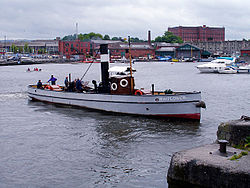- Mayflower (tugboat)
-

MayflowerCareer (England) Name: Mayflower Builder: G.K. Stothert & Marten Cost: £1000 Launched: 18 May 1861 Christened: Mayflower In service: 1861 Out of service: 1964 Homeport: Gloucester Fate: Museum ship in Bristol Harbour General characteristics Tonnage: Registered: 0 tons
Gross: 32 tonsLength: 65 ft (20 m) Beam: 12 ft (3.7 m) Draught: 7 ft (2.1 m) Mayflower is a steam tug (tugboat) built in Bristol in 1861 and now preserved by Bristol Museums Galleries & Archives. She is based in Bristol Harbour at M Shed (formerly Bristol Industrial Museum). She is the oldest Bristol-built ship afloat and is believed to be the oldest surviving tug in the world.[1]
She was built by GK Stothert & Co, who were connected with the Bath-based engineering company Stothert & Pitt. A branch of the family came to Bristol to build railway locomotives (later to become the Avonside Engine Company). After 1852, a separate shipbuilding company was established which survived in business until the 1930s.
Mayflower was built to work on the Gloucester and Sharpness Canal and in the River Severn, one of three tugs ordered after trials had shown how much more efficient than horses they were. Altogether they cost £3000.
Mayflower started working between Sharpness and Gloucester Docks, towing trains of small sailing vessels such as trows and ketches, and, after the new docks at Sharpness were completed in 1874, larger steamers one at a time. By the late 1890s she was the most seaworthy tug in the fleet, and she was altered to make her suitable for work in the Bristol Channel. The old single-cylinder engine was replaced in 1899 with a vertical compound condensing engine supplied, along with a new boiler, funnel, propeller and shafting by W.Sisson & Co. of Gloucester for £940. The steering position, which had previously been behind the funnel, was moved forward, and a waist high iron steering shelter added to give the skipper some comfort. She went back to work outside Sharpness, towing sailing vessels through the dangerous stretches of the Severn Estuary to the mouth of the river Wye and back again.
Around 1907, the Canal Company decided to compete on the River Severn upstream of Gloucester to Worcester. In 1909 Mayflower was again altered when the funnel was arranged to hinge down (counterbalanced with large weights which can still be seen) to enable her to pass under the fixed bridges on this stretch of water. She was now capable of working on every part of the navigation from Worcester to Chepstow, and because of this, became regarded as the training tug in the canal’s fleet, which she continued to be until the end of her working life.
In 1922, she was again altered when the entire deck was raised by 12 inches (300 mm) which meant that the area beneath the deck at the stern could become another cabin albeit with very low headroom. At the same time the bulwarks were cut away down most of each side and replaced with stanchions and chains; this reflected the increased barge traffic on the canal, allowing the crew to step onto laden barges easily.
In the late 1930s, a wooden wheelhouse replaced the steering shelter, and some time after this the bulwarks were replaced. In 1948 the British Waterways Board took control of the canal and made efforts to modernise the tug fleet. All the tugs were either scrapped or had diesel engines installed, except Mayflower, as she was too old to be worth bothering with. She was given the job of ‘mudding tug’ – towing the mud hopper barges filled by the canal dredger to the discharge point. Sometimes she was needed to turn ships at Sharpness Docks and assist them in the entrance lock. In 1962—1963, when the winter was so cold that the canal froze and the diesel tugs had difficulty in working, Mayflower once again took on ship-towing work in the canal. Finally, British Waterways sold Mayflower for scrap in 1967.
By chance, she survived a further fourteen years, slowly deteriorating at her mooring in Gloucester as she was attacked by the weather and by vandals. In 1981 she was purchased by Bristol Museums & Art Gallery and towed back to her birthplace.
Over the next six years Mayflower was restored to working order by a team of volunteers, and she steamed again in 1987. Early in 1988, she steamed back to Gloucester on a courtesy visit.
Mayflower regularly steams during the summer months carrying visitors on trips in Bristol Harbour. She marked her 150th anniversary in May 2011.
Gallery
References
- ^ Steam tug Mayflower 1861 by A. King, Bristol Museums & Art Gallery 1990
External links
- Mayflower at the Register of National Historic Ships
Categories:- Steam tugs
- Tugboats of the United Kingdom
- Bristol Industrial Museum
- 1861 ships
- National Register of Historic Vessels
Wikimedia Foundation. 2010.

